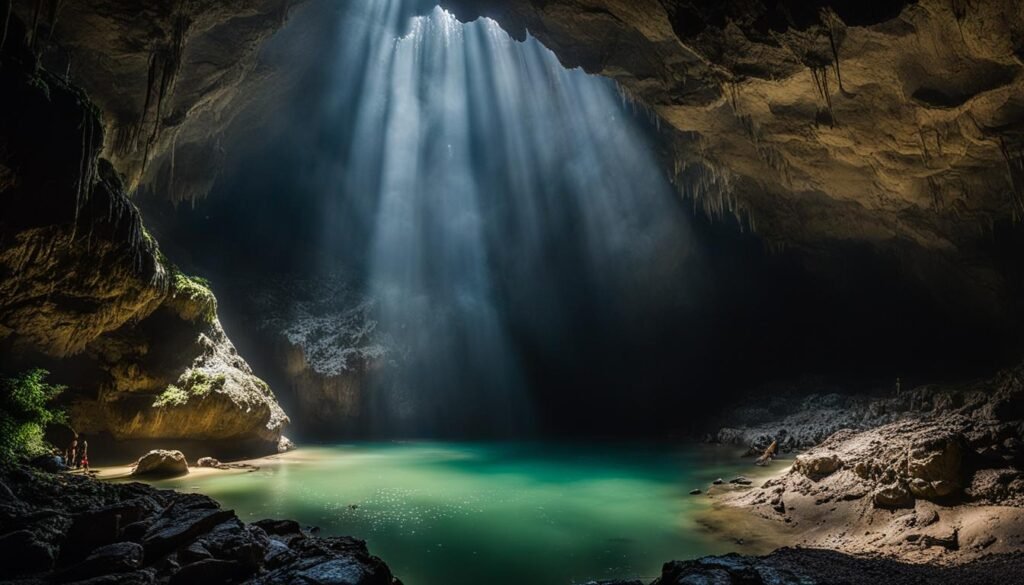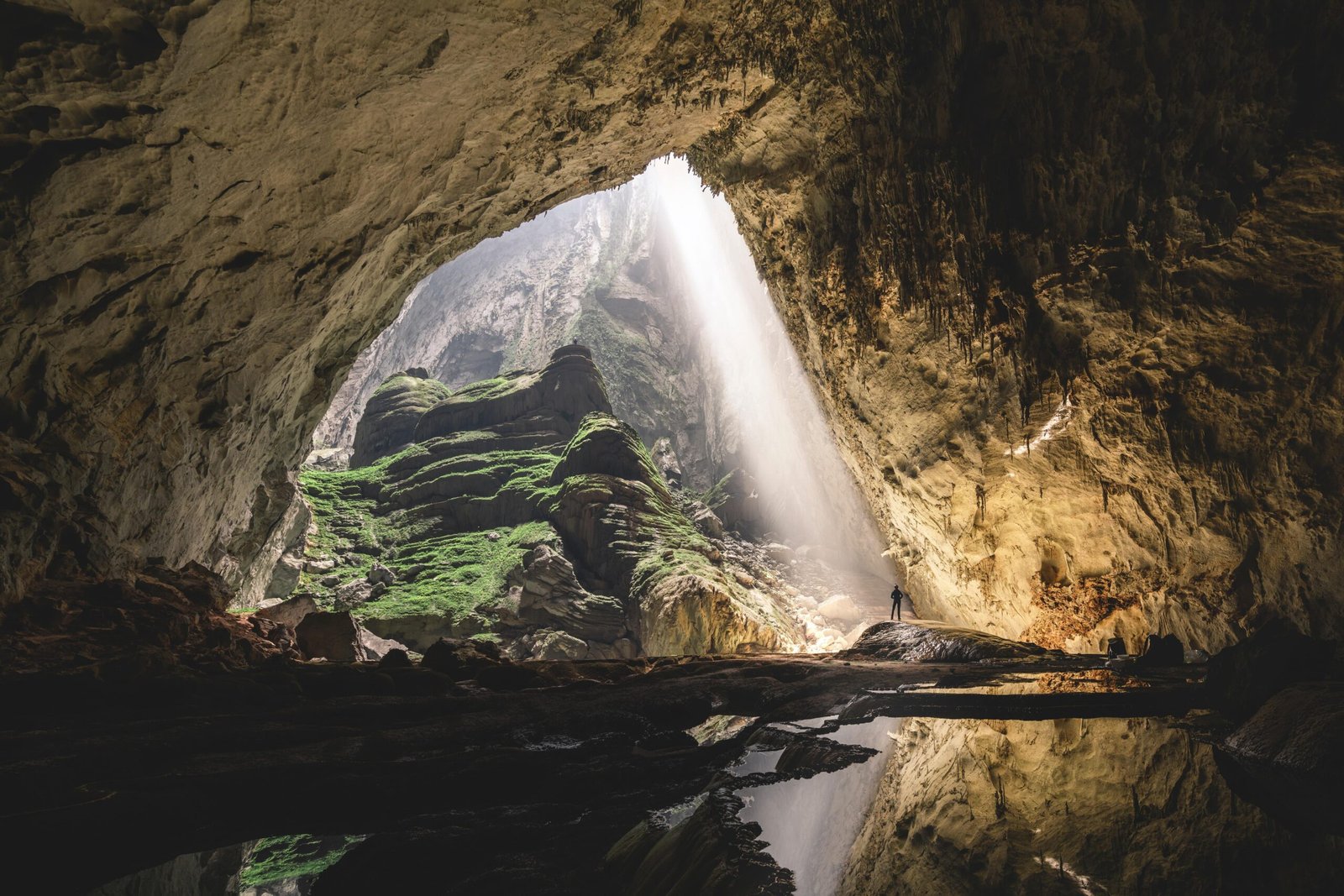Delving into the mysterious underground realms of Vietnam caves presents an unrivaled adventure for explorers at heart. Among the most beautiful caves on Earth, these subterranean wonders offer unforgettable experiences that draw nature lovers and adventurers alike into the heart of Vietnam. Here, beneath the surface, you can witness the majesty of geological formations that have taken millions of years to sculpt. These most famous caves aren’t just tourist attractions; they’re sanctuaries of natural beauty and serenity, carving a primal connection with the very fabric of the land. As you embark on a journey to experience these hidden marvels, prepare to be captivated by the allure that lies beneath the Southeast Asian landscape.
Key Takeaways
- Explore the depth and diversity of Vietnam’s most spectacular caves for a true sense of adventure and discovery.
- Embrace the opportunity to connect with nature by visiting these geological marvels, each with its own unique story.
- Discover why the most famous caves of Vietnam are considered essential destinations for any nature enthusiast.
- Experience the unforgettable moments that await within the heart of Vietnam’s breathtaking subterranean landscapes.
- Learn about the cultural and historical significance that these caves hold, adding another layer to their allure.
- Prepare to have your perceptions of natural beauty redefined by these majestic underground chambers.
Embarking on a Caving Adventure in Vietnam
Immersing yourself in the underground spectacle of Vietnam’s caves is a transformative experience. In central Vietnam, where limestone cliffs tower above Quang Binh Province, lies the iconic Phong Nha-Ke Bang National Park, a UNESCO World Heritage Site that attracts spelunkers and adventurers from all over the globe. Join us as we delve into the intricate preparations and understandings necessary for a successful and enriching caving expedition in the heart of Southeast Asia.
Preparing for Your Cave Exploration Journey
The best time to venture into the depths of Vietnam’s caves is outside the rainy season, to ensure both safety and accessibility. Notable explorations by local figures, such as the discovery of Son Doong Cave by a local man and local farmer, Ho Khanh, play a critical role in the history of the region. Pioneering cave researchers, like Howard Limbert of the British Cave Research Association, further this narrative with their significant contributions.
Selecting the Right Tour Guide and Equipment
Guidance from an experienced tour guide is indispensable, particularly for intricate expeditions like those led by Oxalis Adventure Tours to the Son Doong Expedition. Special equipment, tailored to the demands of the caves’ unique environments, along with the requisite safety gear, will ensure a memorable yet secure caving experience.

Understanding the Local Geography and Climate
The physical tapestry of central Vietnam is etched with limestone cliffs that serve as the geological muses for the country’s extensive cave systems. In Quang Binh Province, a distinctive microclimate within the Phong Nha-Ke Bang National Park adds a layer of complexity to the caving adventure, demanding an appreciation for the region’s climatic rhythm.
Below is a detailed breakdown of the essential factors to consider when planning your caving adventure in Vietnam:
| Aspect | Details | Recommendations |
|---|---|---|
| Season | Avoiding the rainy season significantly reduces risks and enhances access. | Visit between February and April for optimal conditions. |
| Local Expertise | Insights from locals and experts can greatly enrich the exploration experience. | Engage with guides who collaborate with organizations like the British Cave Research Association. |
| Equipment and Safety | Varied terrain demands specialized equipment to navigate the cave’s interior. | Ensure supplied gear meets safety standards and is suited for the specific cave environment. |
| Geography and Climate | Limestone topography and regional climate dictate the cave’s internal conditions. | Familiarize with geo-climatic conditions to better prepare for the varying cave temperatures and humidity. |
With thoughtful preparation and a spirit of adventure, caving in Vietnam promises an extraordinary journey through the subterranean beauty and natural history of one of Southeast Asia’s most treasured landscapes.
Vietnam Caves: The Kingdom of Underground Wonders
Descending into the depths of Vietnam’s most revered caves is like entering a time capsule, where each formation tells the story of Earth’s vibrant past. Amongst them, Son Doong Cave, known locally as Hang Son Doong, stands as the jewel in the crown of Vietnam’s geological treasures. Accompanied by both Paradise Cave and Phong Nha Cave, this trio of magnificent caverns forms a subterranean kingdom of epic proportions, etched into the very heart of Quang Binh Province.
Son Doong Cave: Journey Inside the World’s Largest Cave
Renowned as the world’s largest cave, Hang Son Doong is an awe-inspiring wonder, its reputation as the largest natural cave matched only by the unique ecosystem thriving within its cavernous belly. With colossal chambers large enough to house entire city blocks and its own localized weather system, visitors are often struck by the cavern’s monumental scale. The Great Wall of Vietnam, a 90-meter tall calcite barrier, further adds to the sense of enormity that defines Son Doong.

Paradise Cave: The Longest Dry Cave in Southeast Asia
Thien Duong Cave, better known as Paradise Cave, claims the title of the longest dry cave in Southeast Asia. The 31-kilometer long cavern boasts some of the most spectacular caves within the region, adorned with vast spaces and intricate rock formations that transport explorers into a realm ethereal and untouched. Its outstretched corridors and spacious chambers often leave visitors speechless, surrounded by an otherworldly splendor that resonates with a sense of tranquility and majesty.
Phong Nha Cave: Home to the Underground River and Historic Pathways
Flowing with the serenity of the underground river, Phong Nha Cave stands as an integral part of Phong Nha National Park’s allure. Not only does it offer breathtaking natural beauty, but it also holds historical pathways that date back to the Vietnam War. The intertwining harmony of past and present provides an intricate tapestry for visitors seeking to explore both the beauty and history of the region through the silent echoing halls of Phong Nha.
In a tabulated snapshot, we present the unique features of these underground marvels, encapsulating the essence of these magnificent geological formations:
| Cave | Feature | Significance |
|---|---|---|
| Son Doong Cave | The Great Wall of Vietnam | Known for its massive size; possesses an ecosystem with its own microclimate |
| Paradise Cave | Long Corridors and Grand Chambers | Regarded as the longest dry cave in Southeast Asia with extraordinary rock formations |
| Phong Nha Cave | Underground River and Historical Routes | Features geological beauty and a rich history tied to the Vietnam War |
The depths of Vietnam’s underground sanctuaries are reflective of a world undiscovered, each cave offering a unique voyage into the wonders of nature’s grandeur. From the immense silhouette of Son Doong Cave to the elongated majesty of Paradise Cave, and onto the historic echoes of Phong Nha Cave, Vietnam genuinely embodies the kingdom of underground wonders.
Discovering the Rich Cultural and Historical Significance
Embarking on a journey to Vietnam’s majestic caves, such as Hang En cave and Dark Cave, is an exploration of more than just geological wonders—it’s a profound immersion into the local culture and a timeline of the region’s history. These natural landmarks are steeped in cultural beliefs, stories, and practices that have been passed down through generations.
The spelunking expeditions led by the British Cave Research Association unravel a tapestry of historical and cultural narratives that are as intricate as the caverns themselves. Their discoveries not only highlight the natural splendor of these subterranean ecosystems but also connect us to the rich tapestry of Vietnam’s past.

Understanding the local customs and myths surrounding these caves offers insight into a way of life inextricably linked with nature. Many caves are considered sacred sites, believed to house deities or serve as portals to an ancestral world. For instance, the annual ‘Cave Festival’ showcases the fusion of adventure and spirituality, encapsulating the deep reverence the local population holds for these geological formations.
Below is a brief overview of some of the significant cultural and historical implications tied to the exploration of Vietnam’s caves:
| Cave | Cultural Significance | Historical Relevance |
|---|---|---|
| Hang En Cave | Regarded as a guardian gateway in local lore | Site of archaeological interest with artifacts suggesting ancient human activity |
| Dark Cave | Local myths of spirits dwelling within, influencing respectful cave exploration | Home to significant geological research and biodiversity studies |
| Son Doong & Phong Nha | Central to community-driven conservation efforts | Explored by BCRA, revealing pivotal insights into Vietnam’s geological history |
In addition to enriching Vietnam’s historical context, these discoveries by the British Cave Research Association also significantly contribute to the global scientific community’s understanding of cave formations, ecosystems, and biodiversity. The blending of culture, history, and science epitomizes the unique status that these caves hold within the collective narrative of both the local people and enthusiastic explorers from afar.
Best Times to Visit and What to Expect at Each Cave Site
Each cave in Vietnam offers a distinct experience shaped by its unique geological features and the seasons affecting accessibility and visibility. Understanding the climatic patterns, especially in Central Vietnam, can significantly enhance your exploration journey.
Navigating the Central Vietnam Climate for Optimal Cave Tours
As you plan your adventure through the magnificent Vietnam caves, timing is crucial. The most favorable period for cave visits is the dry season, spanning from November to April. This timeframe generally promises safer conditions and better access to cave entrances. Wet caves like those in Ha Long Bay may require calm sea conditions for a boat ride, while dry caves such as those found in Tam Coc are best traversed by a small boat along rivers like the Ngo Dong, where you can witness the beauty of cave pearls.
Tour Logistics: Entrance Fees, Travel Accommodations, and Exclusive Access
To fully immerse yourself in the experience of Vietnam’s caves, understanding the logistics including entrance fees, accommodation options, and securing exclusive access is key. Most prominent cave sites have set entrance fees that can vary depending on the level of access you seek. To ensure an exclusive experience in certain hidden or protected caves, advanced booking and sometimes special permits are necessary. Accommodations range from budget-friendly hostels to luxurious resorts, catering to every type of traveler.
Tips for First-time Visitors to Vietnamese Caves
For those new to exploring the enchanting caves of Vietnam, here are some essential tips to consider:
- Complete all necessary preparations, including securing a small boat or golf cart for transportation to narrow entrances.
- Equip yourself with a head torch for visibility in dark, winding passages.
- Be mindful of the delicate ecosystem within each cave; observe but do not touch the natural formations, such as cave pearls.
- Bring appropriate footwear for wet and slippery conditions, especially when visiting wet caves.
- Always follow the guidelines provided by your tour guide for safe and respectful caving.

By adhering to these recommendations, your visit to Vietnam’s stunning caves—from the towering structures in Ha Long Bay to the sublime passages of Tam Coc—will be filled with awe and appreciation for these natural wonders.
Conclusion: The Legacy of Vietnam’s Subterranean Wonderlands
The journey through Vietnam’s caves is truly a pilgrimage into the Earth’s depths, presenting unique experiences that beckon with the whisper of adventure. The ethereal beauty of these subterranean landscapes, particularly within the Phong Nha-Ke Bang National Park, offers unforgettable experiences that resonate with the raw essence of Southeast Asia. From the colossal grandeur of Hang Son Doong to the echoing passages of Phong Nha and the tranquil enigma of Paradise Cave, these amazing caves stand as silent witnesses to time’s inexorable march, inviting the intrepid to explore their secrets.
Amidst the geological magnificence, it is incumbent upon us as travelers to tread lightly, honoring the fragile ecosystems and ancient cultural legacies these caves safeguard. The mesmerizing array of stalactites, the clear pools, and the delicate biomes thriving in isolation, are all facets of an intricate world that demands respect and conservation. As explorers, we are but passing guests in these sacred chambers, and our memories and stories are the only souvenirs we should take with us.
Let the allure of Vietnam’s caves summon you to witness nature’s artistry, sculpted over eons. The echoes of history, the chorus of unseen wildlife, and the quietude of earthen chambers combine to create a symphony of the senses, unrivaled by any other on Earth. Embark on this journey to not only discover the cavernous heart of Vietnam but to find a deeper connection with the planet we call home.
FAQ
Why are the caves in Vietnam becoming increasingly popular among tourists?
The caves in Vietnam offer unique and unforgettable experiences for nature lovers and adventurers. With their stunning beauty, immense size, and rich historical and cultural significance, the caves serve as a window into the heart of Vietnam and attract a global audience seeking one-of-a-kind exploration opportunities.
What is the best time of year to visit the caves in Central Vietnam?
The best time to visit the caves in Central Vietnam is during the dry season, which runs from November to April. This period minimizes the risks associated with the rainy season and offers safer and more accessible caving conditions.
Who discovered Son Doong Cave and when?
Son Doong Cave was discovered by a local man, Ho Khanh, in 1990. However, it wasn’t until 2009 that it was explored and publicly announced by a team of scientists from the British Cave Research Association, led by Howard Limbert.
Are the caves in Vietnam suitable for novice explorers?
Yes, many caves in Vietnam are accessible to novices, especially when accompanied by experienced tour guides. Some caves offer easy walks with minimal climbing, making them suitable for a wide range of visitors. It’s important to choose a tour that matches your fitness level and caving experience.
What kind of special equipment is needed for cave exploration in Vietnam?
The equipment needed for cave exploration can include helmets with headlamps, proper footwear for slippery surfaces, gloves, and sometimes harnesses for caves with vertical access. The requirements vary depending on the cave’s difficulty level. Tour operators like Oxalis Adventure Tours provide most of the specialized gear for their expeditions.
Can you explain the significance of Phong Nha-Ke Bang National Park?
Phong Nha-Ke Bang National Park is a UNESCO World Heritage site renowned for its extensive limestone caves and rich biodiversity. It is home to some of the most spectacular and historically significant caves in Vietnam, such as Son Doong Cave and Phong Nha Cave. These caves showcase magnificent rock formations and have been pivotal in understanding the region’s geological and wartime history.
What makes Paradise Cave standout among the caves in Vietnam?
Known locally as Thien Duong Cave, Paradise Cave is celebrated as the longest dry cave in Southeast Asia. It captivates visitors with its enormous interiors and grandiose stalactite and stalagmite formations. The cave extends over 31 kilometers, offering a spacious and heavenly atmosphere that lives up to its name.
How are the Hang En and Dark Caves significant to local culture?
Hang En and Dark Caves hold a special place in local culture with surrounding communities having developed myths and legends about them. Moreover, various discoveries by the British Cave Research Association in these caves have provided valuable insights into the region’s environmental and anthropological history, further enriching Vietnam’s cultural narrative.
What are the entrance fees and travel accommodations like for cave tours?
Entrance fees for cave tours in Vietnam vary depending on the cave’s prominence and the length of the tour. Accommodations range from camping inside or near the caves to staying in local guesthouses or more comfortable hotels. Many tour operators offer package deals that include lodging and travel arrangements.
What should first-time visitors to Vietnamese caves expect?
First-time visitors should expect a blend of adventure and education as they navigate through impressive rock formations and underground rivers. Depending on the cave, you may travel by boat or on foot, and you’ll likely enter through narrow passages. It’s key to go prepared with suitable clothing, a head torch, and an open mind to embrace the beautiful scenery and unique features such as cave pearls.


